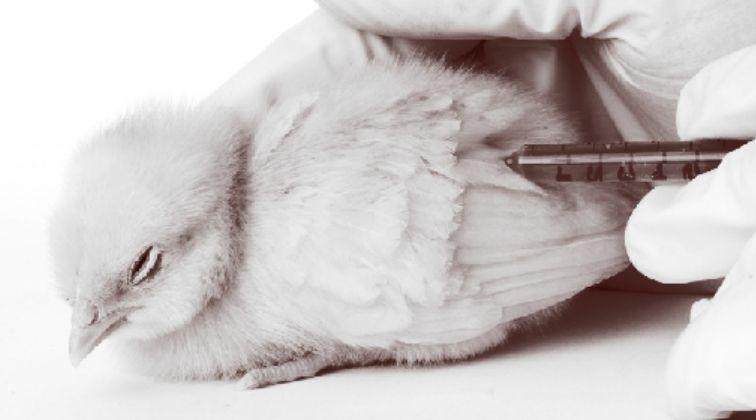戏说流感:那些“H”和“N”的事儿
2013-08-20byMichaeleenDoucleff
by Michaeleen Doucleff
In biology, you cant get much simpler than viruses.
They stick onto cells, pop open and then dump their genes inside to reproduce.
But the naming of viruses isnt so easy to follow.
Theres the new H7N9 spreading through China. And H5N1 is popping up in Southeast Asia. Last summer, H3N2 sickened dozens of people at country fairs.
Oh, lets not forget that 1)pain in the neck H1N1, or the swine flu, which swept through the U.S. in 2009.
What 2)in the heck do all these Hs and Ns mean? H is short for 3)hemagglutinin. And N is short for 4)neuraminidase. More about those in just a moment.
But first, weve got to cover the 5)ABCs.
Influenza comes in three basic types: A, B and C. Those categories tell you a bit about how dangerous the viruses can be.
Influenza C causes the mildest disease. Although influenza B can make you just as sick as A, it has never triggered a worldwide 6)pandemic. Those have all come from the influenza A 7)strains.
Among other things, influenza A viruses are 8)fashionistas. They cover themselves in an array of accessories.
But instead of wearing 9)Dolce and Gabbana, influenza prefers “H & N,” aka hemagglutinin and neuraminidase.
Hemagglutinin and neuraminidase are little protein 10)spikes on the flus surface that help it invade cells.
Just like handbags and shoes, the spikes come in a variety of styles. There are 16 versions of hemagglutinin and 9 for neuraminidase.
Each flu picks out one style from the N rack and another from the H rack. The new bird flu in China, H7N9, covers itself in H7 and N9, while H1N1 is a bit more low-key and goes only for style No. 1 from each.
在生物学里,没有什么比病毒更简单的了。
它们粘附在细胞上,(侵入细胞内)脱壳,把自己的基因丢进去,然后分裂繁殖。
但是,病毒的命名却没那么容易理解。
H7N9这一新型病毒正肆虐中国。H5N1病毒则正在东南亚突然冒出来。去年夏天,H3N2让乡村贸易集市里的很多人感染致病。
噢,我们别忘了那让人头疼的H1N1,或者叫猪流感,它曾经在2009年肆虐美国。
究竟这些“H”和“N”指的是什么?“H”是血细胞凝集素的简写,而“N”是神经氨酸苷酶的简写。我们稍后再谈这两个家伙。
我们首先得来扫扫盲,介绍一些基础知识。
流感分为三种基本类型:甲型、乙型和丙型。这些分类让你知道各种病毒对生命的危害程度。
丙型流感引发的疾病最温和。尽管乙型流感可能导致与甲型流感同等严重的病症,但其未曾触发全球性流行病。肆虐全球的流行病全都出自甲型流感菌系。
甲型流感病毒不但有许多特点,它还是个“弄潮儿”——身上“饰品行头”十足。
不过,流感病毒没有选择穿戴“D & G”的设计品,反而喜欢“H & N”,也就是血细胞凝集素和神经氨酸苷酶。
血细胞凝集素和神经氨酸苷酶是附着在流感病毒表面的微小蛋白质尖状物,能协助病毒攻击细胞。
这些尖状物就像手袋和鞋子一样有着各种各样的款式。目前,血细胞凝集素有16种变体,而神经氨酸苷酶则有9种变体。
每一种流感都会从“N”类中挑出一种变体,从“H”类中挑出另一种变体。在中国爆发的H7N9新型禽流感病毒,以H7和N9两种变体装点自己,而H1N1则比较低调,都挑中了H类和N类的第一种。
11)All told, there are 144 different 12)subtypes of influenza A: from H1N1 to H9N16.
All of them exist in wild birds around the world, so they are all bird flus. But every now and then, one evolves the ability to infect other animals.
H1N1 is one of the more 13)promiscuous. It can infect birds, people, pigs and horses. H2N2, on the other hand, only makes its way into people and birds.
But all influenza A strains are 14)social climbers. Theyre always itching to try out new 15)living quarters.
So they 16)mutate. And they also do something even more 17)insidious: They swap accessories.
Geneticists call it 18)reassortment. And, historically, it signals trouble.
Say a bird gets infected with two viruses: H1N1 and H2N2. When the two viruses reproduce inside the birds cells, H1N1 can grab accessories from H2N2.
This creates a new strain that looks like H2N2 but can now infect people (because it started off as just H1N1).
Thats what happened in 1957 during the Asian flu pandemic, says 19)computational biologist Richard Goldstein, from the National Institute for Medical Research in London.
Since H2N2 had never infected people before, our immune systems had never seen these accessories and thus, we had little defense against it. The new strain ended up killing roughly 70,000 Americans.
甲型流感总共有144种不同的亚型:从H1N1到H9N16。
所有这些亚型病毒都存在于世界各地的野生鸟类身上,因此它们都属于禽流感。但是不时地,就会有一种亚型病毒进化出感染其他动物的能力。
H1N1是其中一种比较“饥不择食”的亚型流感。它能感染禽类、人类、猪和马。另一方面,H2N2却只会感染人类和禽鸟。
不过,所有甲型流感菌系都是“趋炎附势”的家伙,它们总在蠢蠢欲动,试图开拓新的生活领地。
于是,它们学会了变异,也会使出一些更阴险的招数:它们会变装!
基因学家把这种行为称为基因重配。历史经验告诉我们,这预示着麻烦要来了。
假设一只小鸟感染了两种病毒:H1N1和H2N2。当这两种病毒在小鸟的细胞内繁殖时,H1N1可以将H2N2的附着物取为己用。
这就创造出一种看似H2N2、但能感染人类的新型病毒变体(因为它当初就是H1N1)。
那正是1957年亚洲流感大流行时的情况,来自伦敦英国国家医学研究所的计算生物学家理查德·高德斯坦如是说。
因为此前人类从未感染过H2N2病毒,所以我们的免疫系统根本没有见过这些附着物,因而我们对它也就无从抵抗。这一新型病毒变体最终导致约七万美国人死亡。
But the virus didnt stop there. “It then picked up H3 from birds in 1968 to cause the Hong Kong flu pandemic,” Goldstein says. That killed another 30,000 Americans.
What about more recent epidemics?
“The 2009 flu was a real mess,” he says. “The virus had some 20)segments from H3N2 circulating in humans from the 1968 pandemic. It had genes coming in from birds, an H1 coming from pigs and an N1 coming in from a completely different virus,” he says.“They all then mixed together in pigs.”
Scientists are still trying to figure out H7N9.
So far, it looks like the virus got its H from ducks, its N from migratory birds and a splash of other genetic material from chickens, 21)immunologists reported recently in 22)The Lancet.
But how this fashion bug found its way into people is still a mystery.
然而病毒并没有就此罢休。“1968年,它从禽类中挑中了H3变体,从而引发了香港的流感疫情,”高德斯坦说。这次又有三万美国人不幸病逝。
近几年来的大流感又是怎样的情况呢?
“2009年的流感疫情真的是一团糟,”高德斯坦说。“该病毒带有部分来自1968年大流感时在人类中传播的H3N2节片。它拥有源自禽类的基因、源自猪的H1变体以及一种来自某种截然不同的病毒的N1变体,”他说。“它们最终都汇集到猪的身上。”
科学家们目前还在试图摸清H7N9的底细。
免疫学家最近在《柳叶刀》杂志上发表报告称:到目前为止,这一病毒看似从鸭类中获得H变体,从候鸟中获得N变体,以及从鸡身上获得一些其他基因物质。
然而,这一潮流病毒如何入侵人类,至今仍是一个谜。
